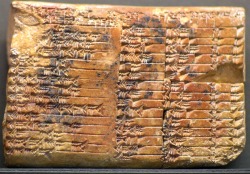History of Pythagorean Triples

One of the earliest examples of Pythagorean Triples is Plimpton 322. Plimpton 322 is a partly broken clay tablet, approximately 13 cm wide, 9 cm tall, and 2 cm thick. New York publisher George A. Plimpton purchased the tablet from an archaeological dealer, Edgar J. Banks, in about 1922, and bequeathed it with the rest of his collection to Columbia University in the mid 1930s. According to Banks, the tablet came from Senkereh, a site in southern Iraq corresponding to the ancient city of Larsa.
The tablet is believed to have been written about 1800 BCE, based in part on the style of handwriting used for its cuneiform script. More specifically, based on formatting similarities with other tablets from Larsa that have explicit dates written on them, Plimpton 322 can be dated to the period 1822–1784 BCE. Plimpton 322 was written in the same format as other administrative, rather than mathematical, documents of the period.
The main content of Plimpton 322 is a table of numbers, with four columns and fifteen rows, in Babylonian sexagesimal notation. The fourth column is just a row number, in order from 1 to 15. The second and third columns are completely visible in the surviving tablet. However, the edge of the first column has been broken off, and there are two consistent extrapolations for what the missing digits could be; these interpretations differ only in whether or not each number starts with an additional digit equal to 1.
In each row, the number in the second column can be interpreted as the shortest side s of a right triangle, and the number in the third column can be interpreted as the hypotenuse d of the triangle. The number in the first column is either the fraction or, where l denotes the longest side of the same right triangle. Scholars still differ, however, on how these numbers were generated.
The tablet is believed to have been written about 1800 BCE, based in part on the style of handwriting used for its cuneiform script. More specifically, based on formatting similarities with other tablets from Larsa that have explicit dates written on them, Plimpton 322 can be dated to the period 1822–1784 BCE. Plimpton 322 was written in the same format as other administrative, rather than mathematical, documents of the period.
The main content of Plimpton 322 is a table of numbers, with four columns and fifteen rows, in Babylonian sexagesimal notation. The fourth column is just a row number, in order from 1 to 15. The second and third columns are completely visible in the surviving tablet. However, the edge of the first column has been broken off, and there are two consistent extrapolations for what the missing digits could be; these interpretations differ only in whether or not each number starts with an additional digit equal to 1.
In each row, the number in the second column can be interpreted as the shortest side s of a right triangle, and the number in the third column can be interpreted as the hypotenuse d of the triangle. The number in the first column is either the fraction or, where l denotes the longest side of the same right triangle. Scholars still differ, however, on how these numbers were generated.
Knowledge of Pythagorean triples:
1.)Megalithic monuments from circa 2500 BC in Egypt, and in Northern Europe, incorporate right triangles with integer sides. Bartel Leendert van der Waerden conjectures that the Babylonians discovered these Pythagorean triples algebraically.
2.)Written between 2000 and 1786 BC, the Middle Kingdom Egyptian papyrus Berlin 6619 includes a problem whose solution is a Pythagorean triple.
3.)The Mesopotamian tablet Plimpton 322, written between 1790 and 1750 BC during the reign of Hammurabi the Great, contains many entries closely related to Pythagorean triples.
4.)The Baudhayana Sulba Sutra, the dates of which are given variously as between the 8th century BC and the 2nd century BC, in India, contains a list of Pythagorean triples discovered algebraically, a statement of the Pythagorean theorem, and a geometrical proof of the Pythagorean theorem for an isosceles right triangle.
5.)The Apastamba Sulba Sutra (circa 600 BC) contains a numerical proof of the general Pythagorean theorem, using an area computation. Van der Waerden believes that "it was certainly based on earlier traditions". According to Albert Bŭrk, this is the original proof of the theorem; he further theorizes that Pythagoras visited Arakonam, India, and copied it.
6.)Pythagoras, whose dates are commonly given as 569–475 BC, used algebraic methods to construct Pythagorean triples, according to Proklos's commentary on Euclid. Proklos, however, wrote between 410 and 485 AD. According to Sir Thomas L. Heath, there was no attribution of the theorem to Pythagoras for five centuries after Pythagoras lived.However, when authors such as Plutarch and Cicero attributed the theorem to Pythagoras, they did so in a way which suggests that the attribution was widely known and undoubted.
7.)Around 400 BC, according to Proklos, Plato gave a method for finding Pythagorean triples that combined algebra and geometry. Circa 300 BC, in Euclid's Elements, the oldest extant axiomatic proof of the theorem is presented.
8.)Written sometime between 500 BC and 200 AD, the Chinese text Chou Pei Suan Ching, (The Arithmetical Classic of the Gnomon and the Circular Paths of Heaven) gives a visual proof of the Pythagorean theorem — in China it is called the "Gougu Theorem" — for the (3, 4, 5) triangle. During the Han Dynasty, from 202 BC to 220 AD, Pythagorean triples appear in The Nine Chapters on the Mathematical Art, together with a mention of right triangles.
9.)The first recorded use is in China (where it is alternately known as the "Shang Gao Theorem", named after the Duke of Zhou's astrologer, and described in the mathematical collection Zhou Bi Suan Jing) and in India, where it is known as the Bhaskara Theorem.
There is much debate on whether the Pythagorean theorem was discovered once or many times.
